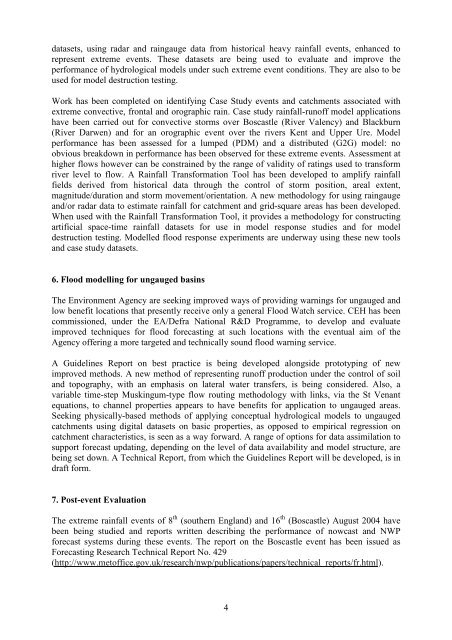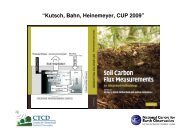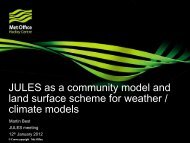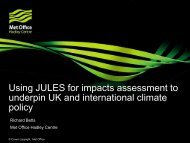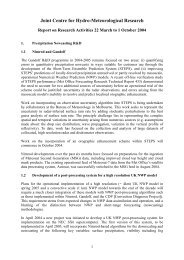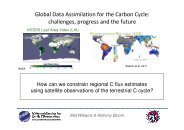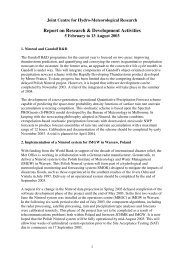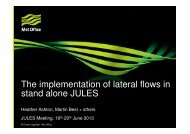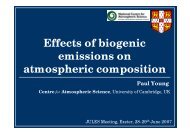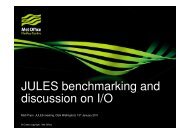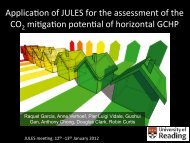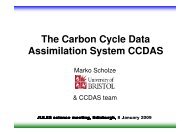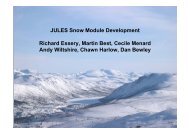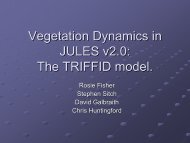Report - Joint Centre for Hydro-Meteorological Research
Report - Joint Centre for Hydro-Meteorological Research
Report - Joint Centre for Hydro-Meteorological Research
Create successful ePaper yourself
Turn your PDF publications into a flip-book with our unique Google optimized e-Paper software.
datasets, using radar and raingauge data from historical heavy rainfall events, enhanced torepresent extreme events. These datasets are being used to evaluate and improve theper<strong>for</strong>mance of hydrological models under such extreme event conditions. They are also to beused <strong>for</strong> model destruction testing.Work has been completed on identifying Case Study events and catchments associated withextreme convective, frontal and orographic rain. Case study rainfall-runoff model applicationshave been carried out <strong>for</strong> convective storms over Boscastle (River Valency) and Blackburn(River Darwen) and <strong>for</strong> an orographic event over the rivers Kent and Upper Ure. Modelper<strong>for</strong>mance has been assessed <strong>for</strong> a lumped (PDM) and a distributed (G2G) model: noobvious breakdown in per<strong>for</strong>mance has been observed <strong>for</strong> these extreme events. Assessment athigher flows however can be constrained by the range of validity of ratings used to trans<strong>for</strong>mriver level to flow. A Rainfall Trans<strong>for</strong>mation Tool has been developed to amplify rainfallfields derived from historical data through the control of storm position, areal extent,magnitude/duration and storm movement/orientation. A new methodology <strong>for</strong> using raingaugeand/or radar data to estimate rainfall <strong>for</strong> catchment and grid-square areas has been developed.When used with the Rainfall Trans<strong>for</strong>mation Tool, it provides a methodology <strong>for</strong> constructingartificial space-time rainfall datasets <strong>for</strong> use in model response studies and <strong>for</strong> modeldestruction testing. Modelled flood response experiments are underway using these new toolsand case study datasets.6. Flood modelling <strong>for</strong> ungauged basinsThe Environment Agency are seeking improved ways of providing warnings <strong>for</strong> ungauged andlow benefit locations that presently receive only a general Flood Watch service. CEH has beencommissioned, under the EA/Defra National R&D Programme, to develop and evaluateimproved techniques <strong>for</strong> flood <strong>for</strong>ecasting at such locations with the eventual aim of theAgency offering a more targeted and technically sound flood warning service.A Guidelines <strong>Report</strong> on best practice is being developed alongside prototyping of newimproved methods. A new method of representing runoff production under the control of soiland topography, with an emphasis on lateral water transfers, is being considered. Also, avariable time-step Muskingum-type flow routing methodology with links, via the St Venantequations, to channel properties appears to have benefits <strong>for</strong> application to ungauged areas.Seeking physically-based methods of applying conceptual hydrological models to ungaugedcatchments using digital datasets on basic properties, as opposed to empirical regression oncatchment characteristics, is seen as a way <strong>for</strong>ward. A range of options <strong>for</strong> data assimilation tosupport <strong>for</strong>ecast updating, depending on the level of data availability and model structure, arebeing set down. A Technical <strong>Report</strong>, from which the Guidelines <strong>Report</strong> will be developed, is indraft <strong>for</strong>m.7. Post-event EvaluationThe extreme rainfall events of 8 th (southern England) and 16 th (Boscastle) August 2004 havebeen being studied and reports written describing the per<strong>for</strong>mance of nowcast and NWP<strong>for</strong>ecast systems during these events. The report on the Boscastle event has been issued asForecasting <strong>Research</strong> Technical <strong>Report</strong> No. 429(http://www.metoffice.gov.uk/research/nwp/publications/papers/technical_reports/fr.html).4


